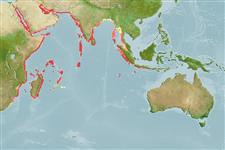Teleostei (teleosts) >
Acanthuriformes (Surgeonfishes) >
Acanthuridae (Surgeonfishes, tangs, unicornfishes) > Acanthurinae
Etymology: Zebrasoma: Derived from Zebra = African horse + Greek, soma = body; referring to the stripes (Ref. 45335).
Eponymy: Julien François Desjardins (1799–1840) was a French zoologist who spent several years on Mauritius. [...] (Ref. 128868), visit book page.
More on author: Bennett.
Environment: milieu / climate zone / depth range / distribution range
Ecology
Marine; reef-associated; depth range 3 - 30 m (Ref. 90102). Tropical; 30°N - 31°S, 30°E - 112°E
Indian Ocean: East Africa and the Red Sea to the Andaman Sea (Andaman and Nicobar Islands, Myanmar and Thailand), western Sumarta and rare in the Christmas Island.
Size / Weight / Age
Maturity: Lm ? range ? - ? cm
Max length : 40.0 cm TL male/unsexed; (Ref. 3146); common length : 32.0 cm TL male/unsexed; (Ref. 3146)
Found in lagoon and seaward reefs to depths greater then 30 m; juveniles in sheltered inner reef areas (Ref. 9710, 48637). Adults usually occur in pairs. Juveniles solitary and commonly among staghorn corals in lagoons or protected reefs (Ref. 48637).
Life cycle and mating behavior
Maturity | Reproduction | Spawning | Eggs | Fecundity | Larvae
Myers, R.F., 1999. Micronesian reef fishes: a comprehensive guide to the coral reef fishes of Micronesia, 3rd revised and expanded edition. Coral Graphics, Barrigada, Guam. 330 p. (Ref. 37816)
IUCN Red List Status (Ref. 130435: Version 2024-2)
Threat to humans
Harmless
Human uses
Fisheries: commercial
Tools
Special reports
Download XML
Internet sources
Estimates based on models
Preferred temperature (Ref.
123201): 25.4 - 29.1, mean 27.6 °C (based on 755 cells).
Phylogenetic diversity index (Ref.
82804): PD
50 = 0.5078 [Uniqueness, from 0.5 = low to 2.0 = high].
Bayesian length-weight: a=0.02344 (0.01123 - 0.04892), b=2.96 (2.79 - 3.13), in cm total length, based on LWR estimates for this (Sub)family-body shape (Ref.
93245).
Resilience (Ref.
120179): Medium, minimum population doubling time 1.4 - 4.4 years (Preliminary K or Fecundity.).
Fishing Vulnerability (Ref.
59153): Low to moderate vulnerability (30 of 100).
Nutrients (Ref.
124155): Calcium = 33.6 [15.3, 101.2] mg/100g; Iron = 0.762 [0.273, 1.754] mg/100g; Protein = 18.2 [16.9, 19.4] %; Omega3 = 0.13 [0.06, 0.27] g/100g; Selenium = 13.5 [4.8, 48.7] μg/100g; VitaminA = 38 [9, 149] μg/100g; Zinc = 1.77 [0.80, 3.15] mg/100g (wet weight); based on
nutrient studies.
